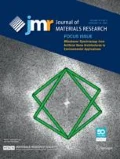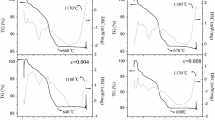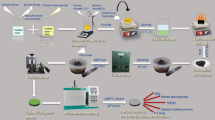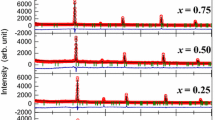Abstract
New lead-free relaxors have been produced from the K0.5Na0.5NbO3–SrTiO3 (KNN-STO) system. The solid solubility within the studied range of compositions (1 -x) K0.5Na0.5NbO3–xSrTiO3 was observed for x up to 0.33. A pseudo-cubic perovskite structure was determined for x = 0.15 to 0.25. The high density and the uniform distribution of fine grains and pores were confirmed by the translucency of these ceramics. The 0.85KNN-0.15STO composition reaches the dielectric permittivity of above 3000 at room temperature. Dielectric spectroscopy measurements revealed that, as with lead-based complex perovskites, the cationic distribution disorder is reflected in relaxorlike properties, thus suggesting possible applications based on this environmentally friendly lead-free ceramic system.
Similar content being viewed by others
References
B. Jaffe, W.R. Cook, Jr., and H. Jaffe: Piezoelectric Ceramics (Academic Press London, New York, 1971), pp. 185-212.
M. Kosec and D. Kolar: On activated sintering and electrical properties of NaKNbO3. Mater. Res. Bull. 10, 335 (1975).
B. Malic, D. Jenko, J. Bernard, J. Cilensek, and M. Kosec: Synthesis and sintering of (K,Na)NbO3, in Solid-State Chemistry of Inorganic Materials IV, edited by M.A. Alario-Franco, M. Greenblatt, G. Rohrer, and M.S. Whittingham, (Mater. Res. Soc. Symp. Proc. 755, Warrendale, PA, 2003), p. 83.
M. Ichiki, L. Zhang, M. Tanaka, and R. Maeda: Electrical properties of piezoelectric sodium-potassium niobate. J. Eur. Ceram. Soc. 24, 1693 (2004).
G.H. Haertling and C.E. Land: Hot-pressed (Pb,La)(Zr,Ti)O3 ferroelectric ceramics for electrooptic applications. J. Am. Ceram. Soc. 54, 1 (1971).
G.A. Smolenskii, V.A. Isupov, A.I. Agranovskaya, and S.N. Popov: Ferroelectrics with diffuse phase transitions. Soviet Physics -Solid State 2, 2584 (1961).
S.L. Swartz and T.R. Shrout: Fabrication of perovskite lead magnesium niobate. Mater. Res. Bull. 17, 1245 (1982).
D. Viehland, S.J. Jang, L.E. Cross, and M. Wuttig: Deviation from Curie-Weiss behavior in relaxor ferroelectrics. Phys. Rev. B 46, 8003 (1992).
L.E. Cross: Relaxor ferroelectrics. Ferroelectrics. 76, 241 (1987).
Z. Kutnjak, C. Filipic, R. Pirc, A. Levstik, R. Farhi, and M. El Marssi: Slow dynamics and ergodicity breaking in a lanthanum-modified lead zirconate titanate relaxor system. Phys. Rev. B 59, 294 (1999).
R. Sommer, N.K. Yushin, and J.J. van der Klink: Polar metasta-bility and an electric-field-induced phase transition in the disordered perovskite Pb(Mg1/3Nb2/3)O3. Phys. Rev. B 48, 13230 (1993).
J.F. Scott and C.A. Paz de Araujo: Ferroelectric memories. Science 246, 1400 (1989).
J. Ravez and A. Simon: Some solid state chemistry aspects of lead-free relaxor ferroelectrics. J. Solid State Chem. 162, 260 (2001).
J. Ravez and A. Simon: New lead-free relaxor ceramics derived from BaTiO3 by cationic heterovalent subtitutions in the 12 C.N. crystallographic site. Phys Stat Solid 178, 793 (2000).
S. Said and J.P. Mercurio: Relaxor behaviour of low lead and lead free ferroelectric ceramics of the Na0.5Bi0.5TiO3—PbTiO3 and Na0.5Bi0.5TiO3—K0.5Bi0.5TiO3 systems. J. Eur. Ceram. Soc. 21, 1333 (2001).
T. Li, L. Li, and Z. Gui: Effect of starting powder-size of BaTiO3 on relaxor behaviour in 0.85BaTiO3—0.15 KNbO3. Ferroelectrics. 261, 113 (2001).
I.P. Raevski and S.A. Prosandeev: A new, lead free family of perovskites with a diffuse phase transition: NaNbO3- based solid solutions. J. Phys. Chem. Solid 63, 1939 (2002).
R.D. Shannon: Revised effective ionic radii and systematic studies of interatomic distances in halides and chalcogenides. Acta Crys-tallogr. A3, 751 (1976).
Phase Diagrams for Ceramists, edited by M.K. Reser (Am. Ceram. Soc, Columbus, OH, 1969), No. 2334.
JCPDS No. 71-2171. International Centre for Diffraction Data: Newton Square, PA, 2002.
JCPDS No. 86-0179. International Centre for Diffraction Data: Newton Square, PA, 2002.
V. Bobnar, B. Vodopivec, A. Levstik, M. Kosec, B. Hilczer, and Q.M. Zhang: Dielectric properties of relaxor-like vinylidene fluo-ride-trifluoroethylene-based electroactive polymers. Macromol-ecules 336, 4436 (2000).
B.E. Vugmeister and H. Rabitz: Dynamics of interacting clusters and dielectric response in relaxor ferroelectrics. Phys. Rev. B 57, 7581 (1998).
Author information
Authors and Affiliations
Corresponding author
Rights and permissions
About this article
Cite this article
Kosec, M., Bobnar, V., Hrovat, M. et al. New lead-free relaxors based on the K0.5Na0.5NbO3–SrTiO3 solid solution. Journal of Materials Research 19, 1849–1854 (2004). https://doi.org/10.1557/JMR.2004.0229
Received:
Accepted:
Published:
Issue Date:
DOI: https://doi.org/10.1557/JMR.2004.0229




